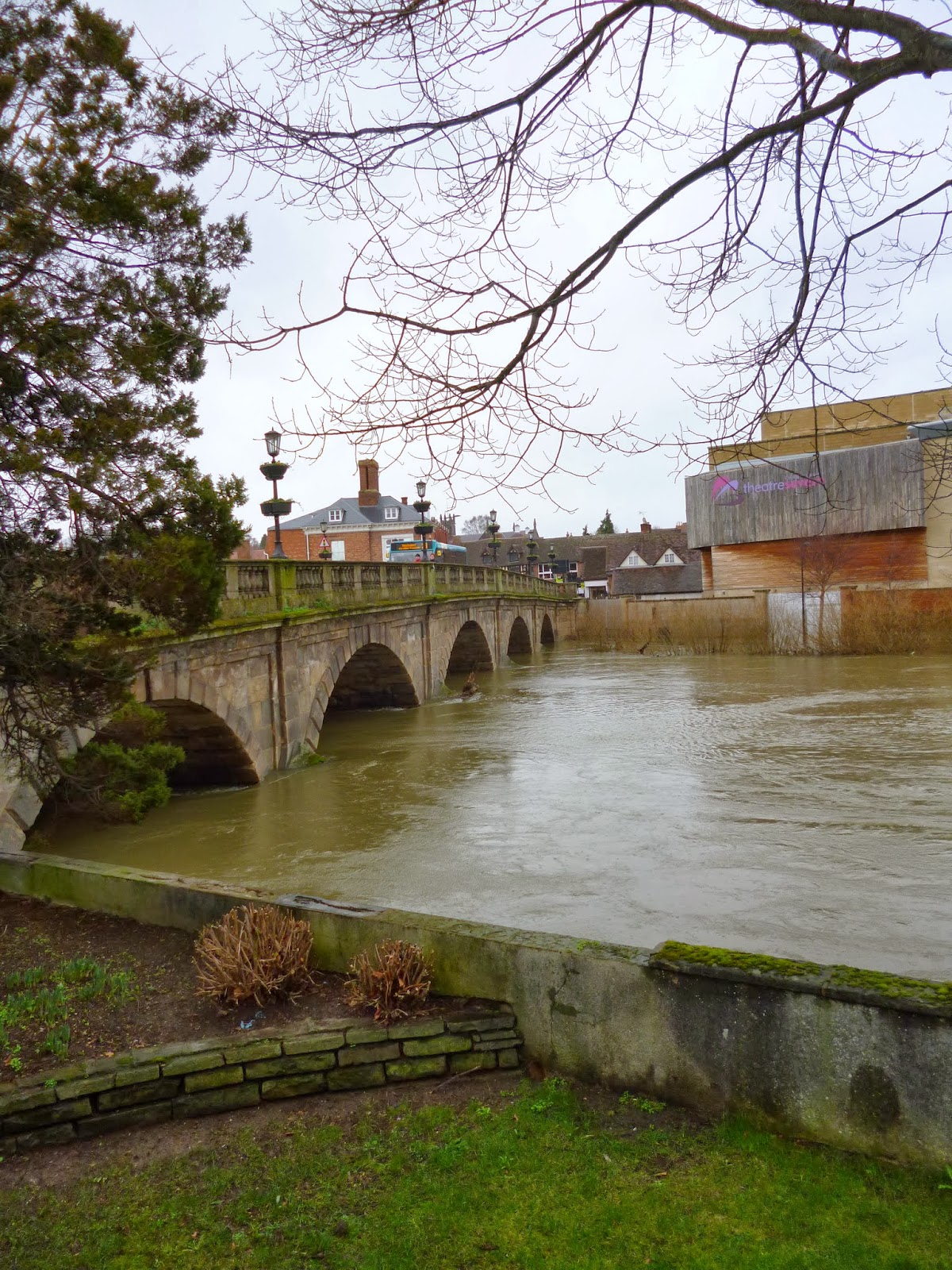 |
| The very high River Severn at Shrewsbury. |
Shropshire has been battered by heavy rain and strong winds over
the last week, as two storms passed over the county within a few days of each
other. Hundreds of trees fell (Shropshire Star, 2014a), including one in my
garden. With the ground already saturated thanks to months of wet weather, the
already swollen River Severn burst its banks at Shrewsbury and Ironbridge,
damaging houses (Shropshire Star, 2014b).
 |
| A fallen tree on Haughmond Hill. |
This has been the wettest January on record for Britain
(Carrington, 2014), so the recent weather is out of the ordinary. But is it
part of the normal variation from year to year that we would expect, or has it
been caused by climate change? And if so, are we likely to experience this kind
of wet and windy weather more often in the future?
What is climate
change?
The climate change we are experiencing now is caused by an
increase in greenhouse gases in the atmosphere. These gases absorb heat from
the sun, warming up the air, and therefore the land or water below. Burning
fossil fuels to heat our homes or generate electricity causes more carbon
dioxide – a key greenhouse gas – to be produced, and destroying forests or
other vegetation means that less carbon dioxide is removed from the atmosphere
through photosynthesis. With more carbon dioxide entering the system than is
being removed, the concentration has risen from 278 parts per million (ppm) in
the pre-industrial period to 400 ppm today. In turn, the global mean temperature
has increased around 0.8°C
over the same period (World Bank, 2012).
Climate change and
rain
Increasing the temperature of the atmosphere affects rainfall
patterns across the world, both in the amount and location of rain. This is
because the warmer it is, the more water evaporates from the surface of the
earth, and also the more water vapour the air can hold – the water-holding
capacity of the atmosphere increases by 7% for every 1 °C increase in temperature
(Trenberth, 2011). It is thought that
the net effect of this “speeding up” of the water cycle will be that dry areas of
the world will get drier, and wet areas of the world will get wetter (World
Bank, 2012). With Britain already famous for its drizzly weather, it seems
likely that Shropshire will receive more rain rather than less.
Scientists use climate models to simulate the effect of
increasing carbon dioxide levels on precipitation. A study by NASA (2013) using
14 models showed that not only will there be more rain in wet areas across the
course of a year, the pattern of rainfall will change so that there are more
days with heavy rain and fewer with moderate rain. The latest report from the
UN’s Intergovernmental Panel on Climate Change (IPCC, 2013) states that by the
late 21st century, it is very likely that heavy precipitation events
will occur more often and more strongly in areas of the world like Europe.
So, in the future our wet weather will come in shorter
bursts, making it more difficult for natural drainage systems to cope and river
flooding more likely. A study by Ciscar et al (2011) showed that if global
average temperatures increased by 2.9 °C above industrial levels, 12,000 people would be affected
by river flooding in northern Britain. If temperatures rise by 3.9 °C, this
figure rises to 48,000.
Were these storms
caused by climate change?
 |
| Shrewsbury's Theatre Severn's flood defences held out. |
Climate change is a long process that has many different and
overlapping effects. It is therefore very difficult to blame any specific
weather event on it, and instead scientists talk about particular aspects of
weather being more or less likely in a warmer world. However, this has not
stopped politicians and some public figures making statements in the last few
weeks either attributing this unusual British weather to climate change, or
actively denying it (Shuckman, 2014).
Interestingly, while there is evidence that specific
instances of very heavy rain in the last few years are due to climate change,
evidence surrounding storms specifically is less clear (Coumou and Rahmstorf,
2012).
Conclusion
Scientific evidence suggests that the unusually high
rainfall levels we have experienced in the last few months may become less
unusual in the future, as increasing global temperatures make Britain an even
rainier place. While we cannot lay definitive blame for the storms of the last
week on climate change, as we move forward we may see clearer patterns
emerging. After all, the climate is really a collection of all our weather, so
we must expect the weather to change unless we reduce carbon emissions
drastically.
References
Carrington D (2014) ‘January was England’s wettest winter
month in almost 250 years’, The Observer,
01/02/14. Available at www.theguardian.com/uk-news/2014/feb/01/january-uk-wettest-winter-month-250-years
Ciscar J, Iglesias A, Feyen L, Szabó L, Regemorter D V and
Amelung B (2011) ‘Physical and economic consequences of climate change in
Europe’, Proceedings of the National
Academy of Sciences of the United States of America. Available at: http://www.pnas.org/content/108/7/2678.full
Coumou D and Rahmstorf S (2012) ‘A decade of weather
extremes’, Nature Climate Change, 2,
491-496. Available at: http://www.nature.com/nclimate/journal/v2/n7/full/nclimate1452.html
IPCC (2013) Climate
change 2013 – the physical science basis: Summary for policymakers. Available
at: https://www.ipcc.ch/report/ar5/wg1/docs/WG1AR5_SPM_FINAL.pdf
NASA (2013) NASA study
projects warming-driven changes in global rainfall. Available at: www.nasa.gov/home/hqnews/2013/may/HQ_13-119_Rainfall_Response.html
Shropshire Star (2014a) ‘Hundreds of trees felled by the
storms’, Shropshire Star, 14/02/14. Available
at: www.shropshirestar.com/news/2014/02/14/hundreds-of-trees-felled-by-shropshire-storm/
Shropshire Star (2014b) ‘Ironbridge residents urged to move
out over flooding’, Shropshire Star, 11/02/14.
Available at: www.shropshirestar.com/news/2014/02/11/waters-rising-as-floods-swamp-shropshire/
Shukman D (2014) Barrage
over climage change link to floods. Available at: http://www.bbc.co.uk/news/science-environment-26242253
Trenberth K (2011) Changes
in precipitation with climate change, Climate Research vol 47: 123-138.
Available at: www.int-res.com/articles/cr_oa/c047p123.pdf
World Bank (2012) Turn
Down the Heat – Why a 4 °C
warmer world must be avoided. Available at: www.worldbank.org/en/news/feature/2012/11/18/Climate-change-report-warns-dramatically-warmer-world-this-century